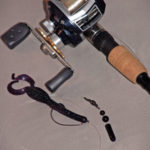
These anglers know Carolina rigs are extremely underrated in Louisiana. They flat-out produce bass when other baits won’t.
Stephen Johnston isn’t one to stir up trouble, but the Louisiana-Texas bass guide won’t hesitate to stir up the bottom. In fact, he says a little silt shaking does wonders for attracting Bayou State bass in muddy southern waters.
For this he turns to a rig whose rather low popularity belies its unquestionable productivity.
In its simplest definition, the Carolina rig puts a leader with an unweighted plastic bait on one side of a swivel and the main line with a weight on the other. When retrieved across the bottom, the weight bumps its way over, through and across whatever it finds, while the bait rides high in the water column.
“What you get is a lot of the silty and muddy bottoms in Southern Louisiana, and if you drag a Texas rig, all you do is form a cloud of mud,” Johnston said. “With a Carolina rig, you can use a short leader, and when a fish comes down to investigate that mud cloud, he’ll see that bait riding above it.”
Requiring a rather monotonous regimen of long casts and slow, plodding retrieves, the rig often ignominiously termed “ball-and-chain,” ranks not among the sexy tactics immortalized by power-fishing pros. No, this one’s more about patience than panache. If you’re the high-strung, overly-caffeinated, run-and-gun type, you probably won’t like this tactic.
However, if you’re into precision presentations, if you like jigsaw puzzles, if you work with children or the elderly, if you can spend a whole day in a tree stand, your fortitude will prove a good match for Carolina-rigging.
When and where
In tournaments, co-angler fortunes often rise and fall on effective Carolina-rigging, but anglers on the front of the boat also find this venerable rig effective for a variety of scenarios. From those muddy bottoms to rock and shell beds to stumps and flooded timber or brush, dragging the rig enables you to cover vast areas to find promising structure and active fish.
Far less temperamental than, say, a topwater or spinnerbait bite, the Carolina rig’s weatherproof dependability means as long as you can control the boat, you can drag a bait. Unless a big wind blows you off the main lake, this under-utilized tool can deliver big results.
Sometimes pigeonholed as solely an offshore, deep-water tactic, Carolina-rigging proves deadly on prespawners moving up to the outer grass lines, ridges, creek mouths and other staging points. These fish are fattening up for the maternity ward, and dragging a C-rig through the right area can stir up trouble in a hurry.
For fish bedding on the inside grass lines, Johnston drags his weight right up to the grass and pauses it so the dust trail settles into the vegetation. This leaves his bait hovering in attractive vulnerability right in the fish’s kill zone.
During summer and winter’s extremes, Carolina rigs excel for dredging the deep stuff. Come fall, when bass follow bait schools back into creeks and coves, probing main-lake points and later those secondary points offers a productive option to cranking.
Rig it right
Carolina-rig weights vary from bullet styles similar to flipping rigs to egg shapes and even cylinders for slipping through persistent snags. Lead sees plenty of action, but the denser and harder tungsten transmits more bottom detail up the line and into your hands. Moreover, tungsten weights are smaller than corresponding lead items, so presentations are more streamlined.
Bassmaster pro Marty Stone prefers tungsten for the rig named after his home state of North Carolina. The denser material, he said, is essential for “reading” the bottom and deciphering all of those little bumps and rattles.
“If you can’t feel what that bait is doing, you’re just throwing something out there and hoping (a fish) comes up and bites it,” he said. “You’re going to miss structure and you’re going to miss a lot of fish. It’s all about the feel.”
Johnston said no matter what scenario he’s fishing, he’ll throw a heavily weighted rig. He’s also a tungsten man, and his choice is a ¾- to 1-ounce weight — even in shallow water.
“A bigger weight will help you get more bites,” he said. “It disturbs more of the mud or grass, and it makes more noise if you’re pulling it through rocks or timber.
“A lot of people are afraid to throw a big weight, but whether it’s 6 inches of water or 20 feet, it causes commotion, and that’s what gets a fish’s attention.”
Also beneficial for attracting attention is the addition of noisy glass or brass beads between the weight and the swivel. Stone uses two composite beads — an 8-millimeter against the swivel and a 6-mm under the weight. Beads enhance his rig’s audible attraction, while protecting his knot from the tungsten’s wearing impact.
Johnston sets his leader length based on water clarity. In exceptionally clear water, he may stretch his bait back 3 feet, but in stained water, he’ll go with a 16- to 18-inch leader. This way, any fish that moves in to investigate the weight’s dust trail will definitely see the bait. Conversely, using a long leader in low visibility may prove counterproductive by pushing the bait out of the fish’s field of vision.
Bassmaster Elite pro Mike Iaconelli, who claimed his 2003 Bassmaster Classic win on the Delta, prefers the superior “bite” of a wide-gap hook for stick baits and other thick-body plastics, while thin worms get an offset hook.
Johnston agrees, noting that unlike the mostly upward hook set associated with Texas-rigged baits, Carolina-rigging requires a different dynamic.
“It’s all about the angle you swing on the fish,” he said. “With a Carolina rig, unlike a Texas rig, you want to use a sweeping hook set.
“I like to point the rod right at the fish, reel up any slack and sweep from 12 to 4 o’clock.”
Presentation and retrieve
The longer your weight is on the bottom, the longer the Carolina rig is doing its job. Therefore, a stout rod with plenty of backbone and a fast tip enables those long casts that keep your rig in the game. Johnston likes a 7- to 7½-foot medium-heavy rod and a 6.3:1 baitcaster loaded with 40- to 50-pound braid, which lengthens his casts and complements the tungsten’s sensitivity.
Stone likes fluorocarbon on his main line and leader — 15- and 17-pound, respectively. Fluoro, he said, sinks fast and gets the bait down to where the fish are, while abrasion resistance repels tough environments.
He, too, likes a long rod, as it extends his effective range: “I stretch it out as far as that weight and fluorocarbon will allow me to throw. Always stay away from the fish. Also, you may come across something you didn’t see before.
“A lot of your bites come on the end of a long cast, and with that fluorocarbon and the longer rod, you can really move some line and drive that hook up in there.”
Stone notes that a fast reel affords the necessary swiftness for long-distance connections. Especially in deep water, Carolina-rig hook sets depend on your ability to quickly transition from a slow dragging motion to a rapid rate of line collection that enables you to drive the hook home.
Stone also avoids jerking on a slack line.
“The fish moves left and you think he moved right; you’re three-quarters of the way into your hook set before you come tight on the fish,” he said. “That’s why I keep all the slack out of my line, so when I set the hook, all the pressure goes into driving that hook into the fish’s jaw.”
Maintaining contact with the bottom is crucial to putting on a good show, so keep the rod low and make lateral sweeps, rather than the upward strokes of Texas-rigging. Picture an eel or a salamander scooting across the bottom. Theirs is a mostly horizontal track, so nix the hopping stuff.
Intrinsic to effective C-rigging is a slow, methodical presentation. Move the bait with the rod and then gather slack with your reel. Moving your bait by reeling greatly reduces your sensitivity — in terms of reading the bottom and detecting strikes. And don’t sweat the swing-and-miss. If a fish bites and you fail to connect, just keep your bait in the strike zone, and if the original bass doesn’t follow up, one of his brethren likely will.
“You always want to stick your rod tip down because when you lift that weight off the bottom, you’re not disturbing anything on the bottom,” Johnston said. “Shorter movements are best, and the finickier the fish, the shorter the drag.
“I’ve seen guys make ‘10-minute casts’ — they cast out their Carolina rig and it takes 10 minutes to work it back to the boat.”
Johnston aims for movements of about 5 to 7 inches at a time. The bait will rise with each move and fall with the pauses. Johnston looks for most of his bites on the fall, but he doesn’t expect much fanfare.
“A lot of people say they can feel the bites with a Carolina rig, but you’ll very seldom feel the bite,” he said. “You’ll feel pressure.
“When you pull against that pressure, the fish will quiver. When a fish has a Carolina rig bait in his mouth, there’s (minimal) weight, but when you pull against him, he’ll think that bait is trying to get away and he’ll eat it.
“Don’t feel for the bump-bump like you would with a Texas rig. Feel for the pressure.”





